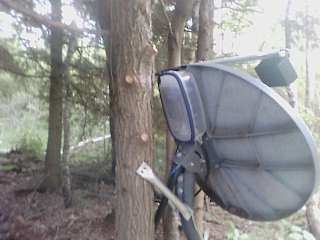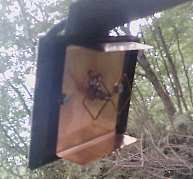
Mark LaPeirre sent me the following email (and pics)
We wanted to share a LAN with my daughter who lives about 1100 ft through dense woods and marsh from our home. We didn't want to run cable outside for this distance and home brew DSL hardware is too expensive anyway. 802.11b seemed like a good choice. Two days with chainsaws, often up to our knees in mud, water, and in the company of thousands of mosquitos, we cleared a straight path about 10 feet wide through the woods and the swamp.
The next obstacle was that her home sits up on a hill from us. The canopy of the trees blocks the line of sight with even a full 10' wide path on the ground. At night we can barely see her back porch light through the path. Short of cutting a 40 or 50 ft wide path, penetrating the canopy with signal seems to be the only way.
We tried the pringles can yagi design. That got us 33% signal strength at best and mostly single digits on the link quality testing with a laptop and a Netgear MA401 card pigtailed into the antenna coax, the other end was the pringles yagi and the WAP11. Not even usable.

Then I found your biquad design on the web. We got two old primestar dishes from the dump and mounted rubbermaid containers on the backs for enclosures. The rubbermaid containers are just like the big rectangular tupperware containers only they seal with a rubber gasket. Inside the enclosures we mounted Linksys WAP11 access points. I inverted the dishes on the mounts to get good alignment since we're not pointing to the sky anymore.
I found some small copper sheets at home depot to make the reflectors out of. Almost the perfect size. $1.49 ea. Trim off about 3/4" up the edge and about 3/16" off the end and bend the ends up for the reflector lips. Drilled a hole in the middle and mounted a TNC balun with the outer casing ground off one side. I bent the element out of #14 copper wire and soldered one center of the biquad to the center pin, and the other to a small piece of copper wire to ground it to the reflector. I found the perfect box at radio shack and mounted the whole thing inside a plastic project case, then bolted it to the old LNB mount. I tested the box first by nuking it in the microwave while I boiled a cup of water on the other side. Water hot... Plastic box cool to the touch. No microwave absorbtion here. The TNC balun protrudes through the box and sticks out in the round hole from the old LNB mount. I connected this with LNR400 coax with soldered on TNC connectors (and lots of silicone goo). I made a home brew reverse polarity TNC adapter out of the old antenna and a new TNC female end.

Interesting note. Both WAP11 units have about the same distance to thier respective houses, about 75'. One is a model 1.1, the other is a model 2.2. We set out to use power over ethernet. The model 1.1 took power through the blue pair and the brown pair with no problem. The model 2.2 would not even take power through a seperate cat 5 cable set up with 2 pair positive and the other two negative. It would cycle the ethernet link lights on and off constantly. Polarity check, still no answer as to why. I plugged it into an extension cord and it works fine. Go figure...
Your design tested at 93% signal strength and 100% link quality on a 1000' shot with one end through the treetops on a wet drizzly day. No visible line of sight. It dosen't get any better than that.